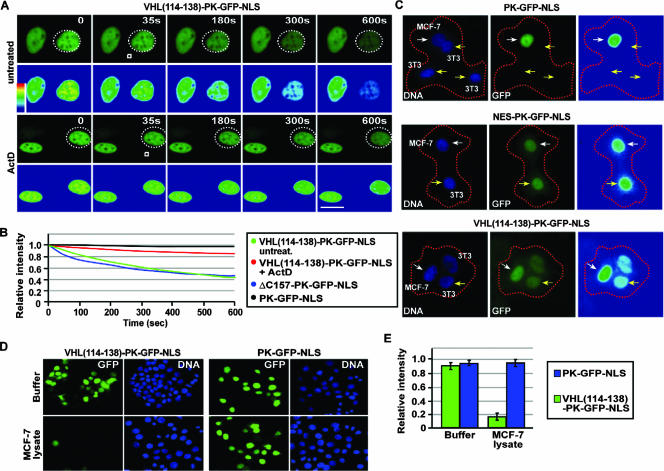FIG. 4.
Residues 114 to 138 mediate transcription-dependent nuclear export of VHL. (A and B) MCF-7 cells were transiently transfected to express VHL(114-138)-PK-GFP-NLS. Cells were treated with a final concentration of 8 μM ActD or left untreated for 1 h before being subjected to photobleaching. Cytoplasmic FLIP was performed by repetitively bleaching a small cytoplasmic region (white squares) of a cell (the dotted circle outlines the cell nucleus). Cells were imaged between pulses, and the corresponding kinetics for the loss of nuclear fluorescence were calculated and are graphed (B). The nuclear export kinetics of ΔC157-PK-GFP-NLS revealed by a cytoplasmic FLIP analysis were plotted (B). Bar, 10 μm. (C) VHL(114-138) can mediate export in a polykaryon fusion assay. MCF-7 cells (donors) were fused with NIH 3T3 cells (acceptors) using PEG, and the transfer of nuclear fluorescence from donor to acceptor cells was monitored. Donor and acceptor cells were differentiated by a cell-specific Hoechst staining pattern. White arrows indicate donor cells, and yellow arrows indicate acceptor cells. Bar, 10 μm. (D and E) VHL(114-138) can mediate export in an in vitro nuclear export assay. MCF-7 cells transiently expressing the indicated constructs were permeabilized with digitonin, after which they were incubated with transport buffer containing ATP, GTP, and an ATP-regenerating system in the presence of buffer or MCF-7 cell lysate. Relative loss in nuclear fluorescence was calculated and plotted on a graph (E).

